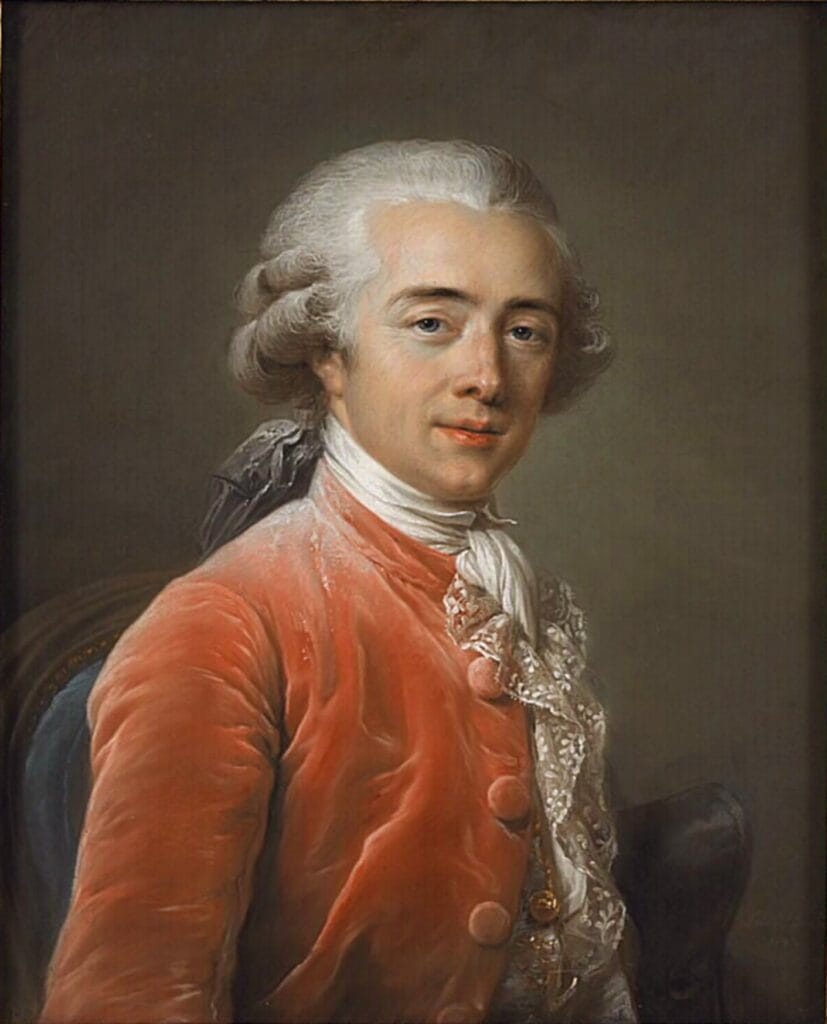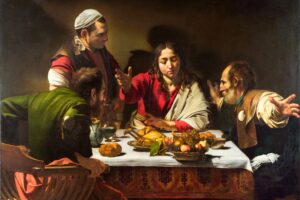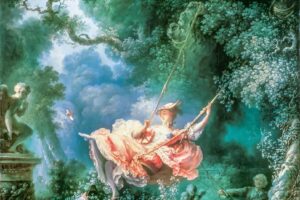Petals and Papers
The Earl of La Forest With His Wife and Daughter – François-André Vincent, 1804 – Neoclassicism
In this luminous interior by François-André Vincent, painted in 1804, public duty and private life share a quiet harmony. The painting presents Louis-Guillaume Otto, Comte de Mosloy—better known as The Earl of La Forest—in a domestic scene with his wife and daughter. It is an image not of grandeur, but of balance: between politics and home, intellect and affection, masculine resolve and feminine grace.
Executed in the neoclassical style, this work exemplifies the refined clarity and moral undercurrent of the era. But beneath the ordered geometry and crisp realism lies something tender—an everyday poetry born of sunlight, blossoms, and glances exchanged.
The Scene Before Us
A stately room opens before us, its proportions precise, its objects meaningful. At right, the Earl sits at a polished desk, writing tools and papers spread before him. A stately clock and classical decor anchor the space in order and discipline. His gaze is lifted—not lost in thought, but gently directed toward the women nearby.
To the left, a cluster of softness and light unfolds. His wife, clad in white and draped in a saffron shawl, tends to a blooming rosebush. Their daughter, radiant in a Grecian blue gown, lifts her hem modestly and clasps a small bouquet. A few petals have fallen to the floor, like punctuation to this quiet dialogue of gesture and gaze.
Golden curtains spill light across the composition. The air is still, but full—with warmth, intelligence, and affection.
The Deeper Meaning
This painting speaks with quiet eloquence about its time. The French Republic had reshaped ideals of virtue, reason, and citizenship. Neoclassical painters like Vincent reflected these values not through storm or spectacle, but through restraint and refinement.
The Earl, once a diplomat who helped negotiate peace between France and America, is shown not as a conqueror, but as a husband and father. His presence is dignified, not dominating. His intellect is grounded by the emotional intelligence of his family.
The women, far from ornamental, become symbols of beauty, growth, and connection. The rose garden is not just decoration—it is an emblem of cultivation, of nurturing both life and values. Their clothes echo classical robes, linking femininity with virtue, not vanity.
This is Enlightenment at home—reason married to emotion, politics to poise.
A Moment Caught in Time
Though painted during Napoleon’s rise to power, this portrait feels far from imperial. It is a personal republic: where clocks tick gently, papers matter, and roses bloom. The painter’s eye is sympathetic, capturing not only likeness, but the emotional geometry of a family in quiet harmony.
We sense no urgency in the Earl’s quill, nor in the daughter’s bouquet. Instead, we see a pause—a moment when the business of the world yields to the rhythms of home. It’s a reminder that even in eras of revolution and reform, history is also made in small rooms, by soft voices, and loving glances.
About Artist

François-André Vincent (1746–1816) was a prominent French painter who, along with his contemporary Jacques-Louis David, was a leading figure of the Neoclassical movement. The two artists were fierce rivals in their youth, both championing a return to the moral and aesthetic values of antiquity. Vincent’s style, however, tended to be more focused on graceful compositions and luminous color than the severe political messages of David, making his work a sophisticated blend of classical ideals and elegant execution.
Artistic Style and Career
Vincent’s training took him to Italy, where he studied under Jean-Honoré Fragonard, and he was later influenced by classical art and the works of Rubens. His style is characterized by:
- Refined Classicism: He employed a clean, linear style with a focus on clear compositions and well-defined forms.
- Lively Color: Unlike the often somber palette of some Neoclassicists, Vincent used a more vibrant and expressive range of colors.
- Historical and Allegorical Subjects: He often drew inspiration from ancient history and mythology to create works that conveyed moral or allegorical messages.
Vincent was a highly respected teacher at the French Academy, and his influence helped shape the next generation of French painters.
Notable Works
- Alcibiades Being Taught by Socrates (1776): This painting is a clear expression of Neoclassical ideals. It depicts the young Athenian general Alcibiades receiving wisdom from the philosopher Socrates. The work’s focus on moral instruction and the dignity of classical figures is a hallmark of Vincent’s style.
- The Earl of La Forest (c. 1779): A magnificent example of his portraiture, this work is not just a likeness but a study in character. It is celebrated for its meticulous detail, particularly in the clothing and textures, and the sitter’s calm, dignified expression.
- The Battle of the Redoubt of Saint-Gervais (1788): A large-scale history painting, this work depicts a scene from a real event. It showcases Vincent’s skill at dynamic composition and his ability to combine historical accuracy with dramatic flair.
- L’Agriculture (c. 1798): This painting is an allegorical scene that idealizes the virtues of rural life and hard work. It reflects the shift in social values during the late 18th century, which often romanticized nature and labor.



